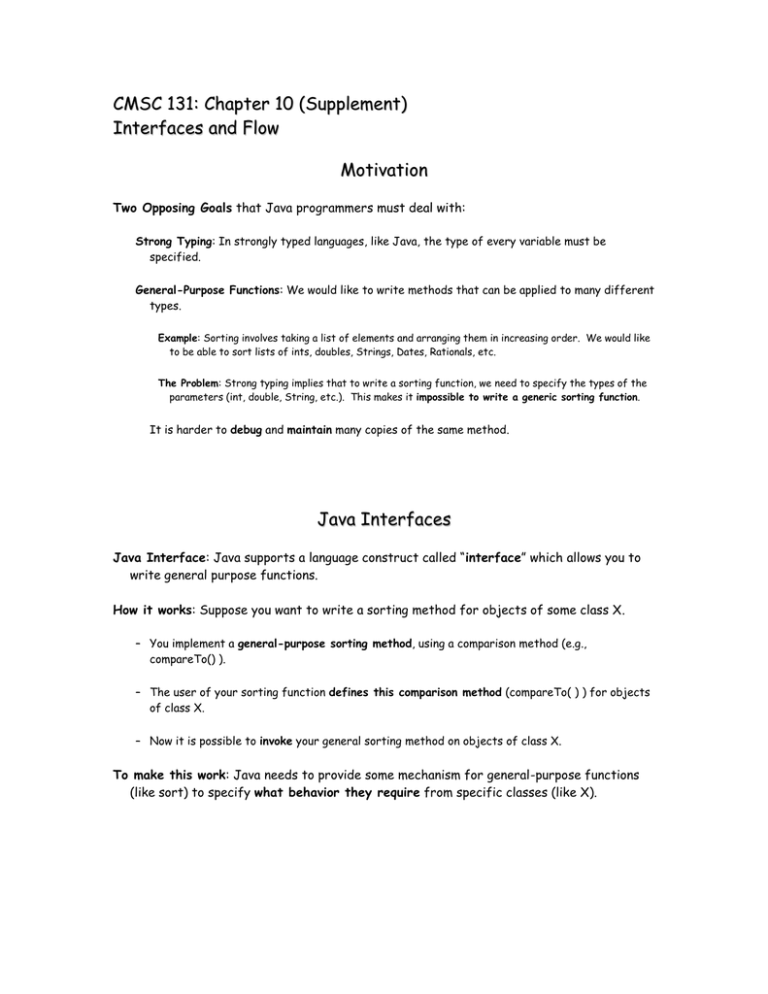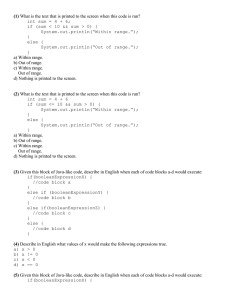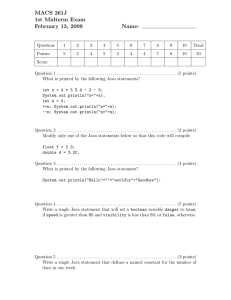C M S
advertisement

CMSC 131: Chapter 10 (Supplement)
Interfaces and Flow
Motivation
Two Opposing Goals that Java programmers must deal with:
Strong Typing: In strongly typed languages, like Java, the type of every variable must be
specified.
General-Purpose Functions: We would like to write methods that can be applied to many different
types.
Example: Sorting involves taking a list of elements and arranging them in increasing order. We would like
to be able to sort lists of ints, doubles, Strings, Dates, Rationals, etc.
The Problem: Strong typing implies that to write a sorting function, we need to specify the types of the
parameters (int, double, String, etc.). This makes it impossible to write a generic sorting function.
It is harder to debug and maintain many copies of the same method.
Java Interfaces
Java Interface: Java supports a language construct called “interface” which allows you to
write general purpose functions.
How it works: Suppose you want to write a sorting method for objects of some class X.
– You implement a general-purpose sorting method, using a comparison method (e.g.,
compareTo() ).
– The user of your sorting function defines this comparison method (compareTo( ) ) for objects
of class X.
– Now it is possible to invoke your general sorting method on objects of class X.
To make this work: Java needs to provide some mechanism for general-purpose functions
(like sort) to specify what behavior they require from specific classes (like X).
Java Interfaces (continued)
A Java Interface is a formal way for a class to promise to implement certain methods. We
say that a class implements an interface if it provides these methods.
Interface:
– Is defined by the keyword interface (rather than class).
– It defines methods, but does not provide a method body (the executable statements that
make up the method).
Defining a Java Interface:
– A Java interface is collection of method declarations.
– These declarations are abstract, which means that we do not supply the body of the method.
public interface Y {
public void someMethod( int z );
public int anotherMethod( );
}
– These methods are usually public, since they are expected to be part of an object’s public
interface.
– Notice that an interface is not a class. For example, you cannot create an instance using “new
Y”.
Implementing an Interface
Implementing Java Interface:
– A class is said to “implement” an interface if it provides definitions for these methods.
– To inform Java that a class implements a particular interface Y, we add “implements Y” after
the class name:
public class X implements Y {
// …(instance data and other methods)…
public void someMethod( int z ) { /* give implementation here */ }
public int anotherMethod( ) { /* give implementation here */ }
}
– Now, we may use an X any place that an object of type Y is expected.
–
Review of Control Flow
Control Flow: Controls the order in which statements are executed in your program
if and if-else: Conditionally execute a block of statements based on a boolean conditional
expression. Example:
if ( option == 1 )
System.out.println(
else if (option == 2 )
System.out.println(
else if ( option == 9 )
System.out.println(
else
System.out.println(
“Read image” );
“Double” );
“Quit” );
“Sorry, invalid” );
while and do-while loops: Repeatedly execute some block of statements as long as a condition
holds.
The Switch Statement
Switch Statement: is a convenient (and often more efficient) way to perform a multi-way
conditional based on a single control value.
Example:
switch ( option ) {
case 1:
System.out.println(
break;
case 2:
System.out.println(
break;
case 9:
System.out.println(
break;
default:
System.out.println(
break;
}
"Read image" );
"Double" );
"Quit" );
"Sorry, invalid" );
The Switch Statement
General form:
switch ( control-expression ) {
case case-label-1 :
statement-sequence-1
break;
case case-label-2 :
statement-sequence-2
break;
…
case case-label-n :
statement-sequence-n
break;
default :
default-statement-sequence
break;
}
The Switch Statement
The control expression can be of one of the following types:
char, int, short, byte.
• not float or double,
• not boolean or long
• not an object (Too bad! Strings would have been nice.)
The “break” statement jumps out of the switch statement. Otherwise control flow just “falls
through” into the next case.
int option = 2;
switch ( option ) {
case 1:
System.out.println(
case 2:
System.out.println(
case 9:
System.out.println(
default:
System.out.println(
}
"Read image" );
"Double" );
"Quit" );
"Sorry, invalid" );
The Switch Statement
The falling though behavior is handy, because it allows you to combine cases. Example: Allowing either
upper-case or lower-case for characters:
char command = 'D';
switch ( command ) {
case 'i':
case 'I':
MyUtility.insert( );
numberOfItems++;
break;
case 'd':
case 'D':
MyUtility.delete( );
numberOfItems--;
break;
…
}
The Switch Statement
The “default” case is optional. If it is not included, and no case matches, then the switch statement
does nothing.
It is considered good practice to always include a default case, if only to print an error message of
an illegal choice.
Cases are not required to be in order. The following is legal, but is confusing for the reader.
switch ( option ) {
case 2:
…
case 9:
…
default:
…
case 1:
…
}
Recommended: List cases in increasing order, and put the default last.
The For Loop
Common loop structure:
sum = 0.0;
n = 1;
while ( n <= 3 ) {
sum += n;
n++;
}
initialization
while ( boolean-test ) {
loop-body
update
}
The for loop provides a shorthand for expressing this type of loop:
for ( initialization; boolean-test; update ) {
loop-body
}
The above loop is equivalent to:
sum = 0.0;
for ( n = 1; n <= 3; n++ ) {
sum += n;
}
The For Loop: Examples
Loop that counts from 100 down to 0: (100, 99, 98, …, 1, 0)
for ( count = 100; count >= 0; count-- )
System.out.println( count + “ bottles of beer on the wall” );
Loop that counts by twos from 0 up to max+10: (0, 2, 4, …, max+10)
for ( m = 0; m <= max+10; m += 2 ) {
// … something exciting …
}
It is very convenient to declare the loop-control variable within the initialization. The scope
of the variable is limited to the for loop:
for ( int i = 0; i < 20; i++ ) {
sum = sum + i;
}
System.out.println ( i );
// this is a compiler error: i only accessible inside the loop
The For Loop: Further Elements
Multiple Initialization/Increment: Sometimes it is useful to have multiple initializations and
multiple increments. This can be achieved by separating the operations by commas.
Example:
for ( m = 0, n = 100; m < n;
// … something senseless …
}
m++, n -= 2 ) {
Equivalent to:
m = 0;
n = 100;
while ( m < n ) {
// … something senseless …
m++;
n -= 2;
}
The For Loop: Common Errors
Semicolon after the increment:
for ( int j = 0; j < 100; j++; ) System.out.println( j );
Semicolon after closing parenthesis:
for ( k = 0; k < 10; k++ ) ;
System.out.println( k );
The println is executed only once, after the loop exits (prints 10).
Infinite loop due to careless loop condition:
Example: The following intended to count from low up to high-1.
int low = …
int high = …
for ( z = low; z != high; z ++ ) {
…
}
// what if high < low?
Random Number Generation
Pseudo-Random Numbers: Random numbers generated in Java (and all other programming
languages) are not truly random. They are simply so unpredictable that they behave as
if they are random for all practical purposes.
Seed Value: A sequence of pseudo-random numbers is uniquely determined by an initial seed
value, which is given as a long integer.
Math.random( ): Returns a pseudo-random double r in the range
0.0 ≤ r < 1.0
It works by invoking Java’s more general Random number class, which resides in the
java.util package.
Java’s Class Random
Package: java.util (import java.util.*; )
Constructors: Each call to “new Random” creates a new pseudo-random sequence.
– Random( long seed ): Creates a new sequence using the given seed. Given the same seed, the
same sequence is generated every time.
– Random( ): (Default constructor) Creates a sequence using the time of day as the seed. The
sequence is different every time you run it.
Getting a new Random Value:
–
–
–
–
–
nextBoolean( ) : Returns a random boolean
nextInt( ) : Returns a random int (over the entire range of int’s)
nextInt( int n ) : Returns a random int r over the range 0 ≤ r ≤ n-1.
nextDouble( ) : Returns a random double r, where 0.0 ≤ r < 1.0.
Also: nextFloat( ), nextLong( ), setSeed( long seed ).
Why seeds?
The “break” Statement
We saw that the break statement exits from a switch statement. It can also be used to
exit immediately from any loop:
– while
– do-while
– for
Example: Generate up to 500 random numbers, but exit the loop as soon as a value less than
0.01 is generated.
int count;
for (count = 1; count <= 500; count++ ) {
if ( Math.random( ) < 0.01 ) break;
}
System.out.println( "count = " + count );
The “break” Statement
Warning: A break “violates” the loop’s natural structure, and can be hard on the reader
(particularly if the loop is large). It is best to avoid them, unless it is needed to keep
the code simple.
Example: We can easily avoid the break in the above example, by creating a boolean variable.
boolean foundIt = false;
for (count = 1; ( count <= 500 && ! foundIt ); count++ ) {
if ( Math.random( ) < 0.01 ) { foundIt = true; count--}
}
System.out.println( "count = " + count );
The “continue” Statement
The break statement exits entirely from a loop.
The continue statement is similar, but jumps immediately to the test portion of the loop,
ready to start a new iteration.
Example:
count = 1;
while ( count < 20 ) {
sum += count;
if ( … ) break;
if ( … ) continue;
}
System.out.println( “Done” );
// continue jumps here
// break jumps here
Warning: We only mention continue for completeness.
break: Is usually bad practice. Use it very sparingly.
continue: Is considered bad practice. Avoid it altogether.





